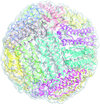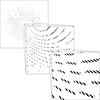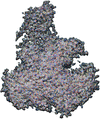issue contents
November 2021 issue

scientific commentaries
PHYSICS | FELS
Nass et al. [IUCrJ (2021), 8, 905–920] applied a wide bandwidth beam (pink beam) to serial femtosecond crystallography at X-ray free electron lasers. This approach will lead to better datasets in a shorter time from fewer crystals.
MATERIALS | COMPUTATION
Tchoń & Makal [IUCrJ (2021), 8, 1006–1017] use numerical simulations to explore the dependence of data completeness on crystal orientation, X-ray energy and diamond anvil cell geometry for high-pressure diffraction experiments. Their completeness heat maps for different Laue classes can be used to guide optimization of high-pressure single-crystal diffraction experiments.
BIOLOGY | MEDICINE
As we respond to viral epidemics and accelerate the discovery of new viruses, sifting through vast volumes of structural virology data could rapidly become an impossible task. virusMED is a curated atlas of metal/drug-binding and immunological hotspots in viral protein structures that provides a navigation guide for structure–function analysis and the development of antiviral strategies.
research letters
CHEMISTRY | CRYSTENG
Download citation


Download citation


A time-resolved crystallization study of early-stage carbamazepine crystallization by cryoTEM reveals two crystallization pathways, one classical and the other non-classical. Four forms of carbamazepine are also identified via 3D electron diffraction from a single crystallization.
research papers
CRYO | EM
Samples for single-particle cryo-electron microscopy can be routinely vitrified using only liquid nitrogen at its boiling temperature, allowing sample handling workflows to be simplified and sample stresses that contribute to beam-induced motion to be reduced.
BIOLOGY | MEDICINE
Single-millisecond mix-and-inject experiments are presented on ligand binding to an enzyme performed at the European Free-Electron Laser with high X-ray repetition rates.
BIOLOGY | MEDICINE
Higher X-ray energies are experimentally demonstrated to be highly beneficial for macromolecular crystallography.
PHYSICS | FELS
Large-bandwidth X-ray free-electron laser pulses significantly reduce sample and beam-time quantities required for obtaining accurate structure-factor amplitudes in serial femtosecond crystallography.
PDB references: Structure of thaumatin determined at SwissFEL using native SAD at 5.99 keV with photon-energy BW of 0.26%, 7o44; Structure of thaumatin determined at SwissFEL using native SAD at 6.02 keV with photon-energy BW of 2.15% and pinkIndexer with 30 000 indexed images, 7o5k; Structure of thaumatin determined at SwissFEL using native SAD at 6.02 keV with photon-energy BW of 2.15% and XGANDALF, 7o51; Structure of thaumatin determined at SwissFEL using native SAD at 6.02 keV with photon-energy BW of 2.15% and pinkIndexer, 7o5j; Structure of thaumatin determined at SwissFEL using native SAD at 6.02 keV with photon-energy BW of 2.15% and XGANDALF with 50 000 indexed images, 7o53
BIOLOGY | MEDICINE
MltA from the human pathogen Acinetobacter baumannii was characterized and its dimeric crystal structure was unveiled, demonstrating the extra-domain-mediated dimerization of MltA for the first time. Based on the current structural and biochemical studies, the working mechanism of MltA with various functionally related proteins on the bacterial outer membrane was modeled.
PDB reference: MltA, 7esj
BIOLOGY | MEDICINE
virusMED (Virus Metal binding sites, Epitopes and Drug binding sites) is a rich internet application based on a database of atomic interactions around hotspots in 7041 experimentally determined viral protein structures.
CRYO | EM
This work describes cryo-TEM simulations of amorphous radiation-sensitive samples using multislice wave propagation, and by introducing the `frozen plasmon' method. Combined with a coarse-grained all-atom solvent model, this accurately models inelastic scattering effects leading to radiation damage, solvent motion and contrast loss.
BIOLOGY | MEDICINE
Crystal structures of oxy–deoxy intermediates of a 400 kDa giant hemoglobin reveal the allosteric transition intermediates of the unmodified protein and unrestrained oxygen saturation, which have been missing pieces in the study of the allosteric behavior of hemoglobins over the last half century.
NEUTRON | SYNCHROTRON
Download citation


Download citation


A combination of neutron powder diffraction and ab initio random structure searching was used to locate hydrogen positions in the crystal structure of metatorbernite [Cu(UO2)2(PO4)2·8H2O], a common autunite mineral that shows promise for uranium remediation.
CCDC reference: 2102876
BIOLOGY | MEDICINE
Understanding the catalytic mechanism of SARS-CoV-2 main protease (Mpro) can help in guiding drug design of specific small-molecule antivirals. A 2.0 Å resolution room-temperature X-ray crystal structure of inactive C145A mutant Mpro in complex with the octapeptide Ac-SAVLQSGF-CONH2 that resembles a Michaelis complex is reported.
PHYSICS | FELS
Two orientation methods are compared: the expansion maximization compression (EMC) algorithm and the correlation maximization (CM) algorithm. To investigate the efficiency, reliability and accuracy of the methods at various X-ray free-electron-laser pulse fluences, simulated diffraction patterns of biological molecules are used.
CRYO | EM
A new tool based on 3D Zernike polynomials is presented that allows the study of the continuous heterogeneity of biological macromolecules, revealing the structural relationships present among different states by the approximation of deformation fields.
MATERIALS | COMPUTATION
Download citation


Download citation


The influence of a diamond anvil cell (DAC) aperture, incident radiation wavelength and sample orientation in a DAC on the completeness of diffraction data collected at high pressure has been systematically analyzed. The considerable impact of sample orientation on achievable data completeness has been confirmed and quantified for all Laue classes in the form of graphical guides. These guides have been applied to predict sample orientation for structural analysis of a sample undergoing an orthorhombic → monoclinic phase transition under pressure which ensured over 90% completeness.
MATERIALS | COMPUTATION
Download citation


Download citation


For the first time, AAh boron nitride (BN) crystal, assigned to an orthorhombic space group (No. 31, Pm21), is reported. The structure of BN nanotubes is reinterpreted as a helix, resulting from texture and helical growth of the AAh BN crystal used.
CCDC reference: 2107341
MATERIALS | COMPUTATION
Many pathological side-effects of diabetes and aging are directly linked to non-enzymatic glycation of collagen as an abundant, multi-purpose tissue in human beings. We describe a model that quantifies glycation and its structural effects as a function of sugar level (glucose and ribose) and time, based on SAXS and WAXS data.



 journal menu
journal menu




 access
access
































